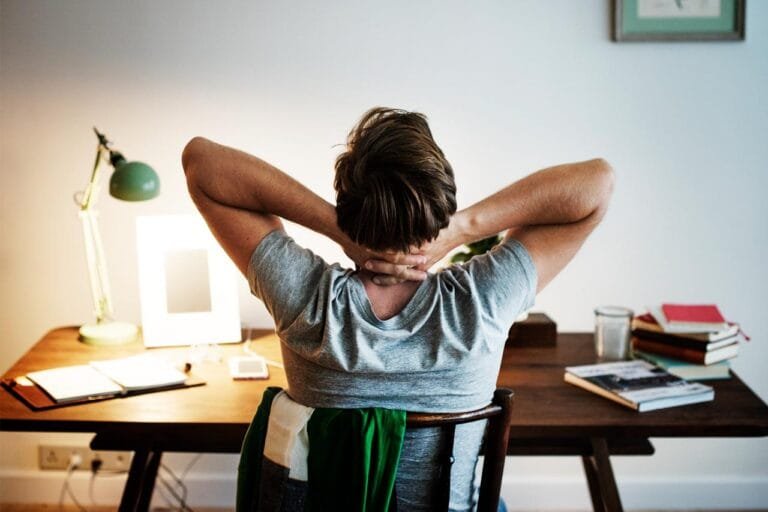Lower back pain is incredibly common and perhaps the greatest reason for calling in sick. Our lower backs support the weight of the upper body and are subject to a relentless mountain of stress, strain, pulls, and pushes, movements like lifting and twisting can quickly cripple us.
Four things usually create lower back pain: sudden injury, simply getting older, arthritis, and exercise. Whatever the source of your lower back pain, here’s 10 recommendations that can really help relieve it, prevent future problems, and possibly even fix it!
List of 10 tips for living with lower back pain
- Always maintain correct posture doing EVERYTHING
- Maintain correct posture when sitting at your desk, eating, etc
- Always, always use ice or heat
- Maintain a healthy weight for your body type
- Stretch your muscles
- Get off on the right foot
- Back to exercise
- It’s okay to use over-the-counter pain relievers, but respect them
- Massage aches away
- Sleeping on a quality mattress, matters
1. Always maintain correct posture doing EVERYTHING
To protect your lower back, it’s paramount you sustain proper posture when moving—especially if you play a sport or your work includes repetitive movements.
Don’t slouch and always keep your spine erect. When lifting, bend from the knees and be sure to engage your hips and core when twisting side to side.
2. Maintain correct posture when sitting at your desk, eating, etc
You can really alleviate lower back pain by keeping proper posture when sat down. If you have a desk job, plant your feet on the floor and use a good chair that provides adequate and if possible, adjustable lower back support. Avoid slouching forward to your screen.
3. Always, always use ice or heat
When you’ve injured your lower back, applying ice within the first 24-72 hours can go a long way to helping with pain and swelling.
After 72 hours, switch to heat (like a hot water bottle) to relax tight, aching muscles. Heat can be great for chronic lower back pain.
Please don’t use hot or cold applications for more than 20 minutes at a time, your skin won’t thank you for it.
4. Maintain a healthy weight for your body type
You’ve heard it a million times. Being overweight increases the load on your lower back, especially as you age.
It’s not just your back though, it increases the load on everything else… tendons, ligaments, joints, etc…
Follow your docs recommendations for diet and exercise and try and keep your body weight within a healthy range for your height and age.
5. Stretch your muscles
Streeeettcchhhing is a superb way of relieving chronic and acute lower back pain, it can also really help prevent lower back issues.
The muscles in the back span out in many directions so it’s important to include a few different stretches in your routine. Basic lower back stretches include:
- Lying flat on your back and gently pull your knees toward your chest.
- Lay flat on your back with arms out, bend one knee, and twist towards your straight leg while trying to touch your bent knee to the floor (called a spinal twist). The Seated Spinal Twist is also brilliant.
- Lay on your front, arms stretched overhead like superman, and lift your chest and/or legs off the.
6. Get off on the right foot
The right footwear will improve your posture, increase stability, and lower the risk of experiencing lower back pain. Always wear the correct footwear for your activity.
Wearing unsupportive shoes now and then like flip flops, sliders, or high heels is not going to cause major lower back issues, but prolonged use can put increased pressure on your lower spine and discs. I for one, cannot wear flip-flops.
7. Back to exercise
It’s really easy to stay in bed if your lower back pain is crippling. Ironically, moving around (carefully) can help your lower back get better quicker.
It’s critical, however, that you stick to your own comfort zone, if something makes your back hurt more… stop it.
8. It’s okay to use over-the-counter pain relievers, but respect them
Anti-inflammatories can help lower back pain by reducing swelling. For maximum benefit, it’s important to take them regularly for a few days to alleviate your lower back pain, if it’s not a serious injury.
They’re not for everyone, so check with your doctor before taking them… and never take on an empty stomach. Ever.
9. Massage aches away
Massage is undoubtedly an excellent way to relieve tight and tense muscles in the lower back. In the right hands, lower back spam can respond miraculously.
Keeping those lower back and core muscles in condition will pay dividends, preventing future lower back problems.
10. Sleeping on a quality mattress, matters
Lower back pain sufferers will always feel better from sleeping on medium-firm mattresses. Importantly though, your usual sleep position should influence your mattress purchase.
Side sleepers sometimes plump for a softer mattress whilst back sleepers usually choose firmer mattresses. I never sleep on my stomach.
If your lower back pain doesn’t show improvement after 2 to 6 weeks of self-help you should see your doctor. You should contact your health advisor straight away if you have any “red flags,” including:
- A history of cancer or a recent infection
- A recent fall or other accident
- Extreme fatigue
- Rapid weight loss
- Signs of infection, such as fever, chills, sweats
- Nerve problems, such as shooting pain, numbness, or tingling
- Changes in bowel or bladder function
Other options for treating lower back pain may include physical therapy, pain management with cortisone injections, or occasionally surgery… but that is always the last resort.
Lower back surgery can help people with permanently damaged discs and pinched nerves, but it’s not for people with other types of lower back pain, the most common being muscular related.
Stay safe.
Also Check: Best chair for back pain relief: Bad chair, bad back




